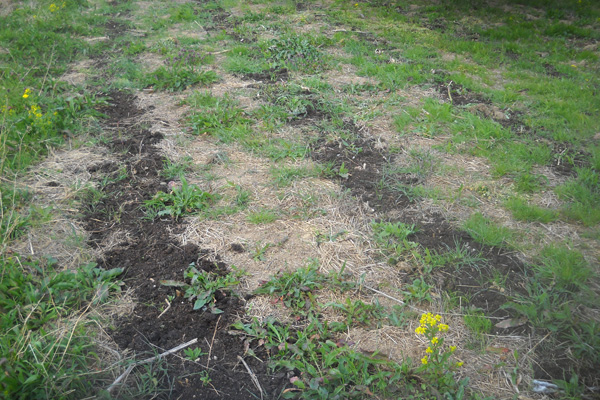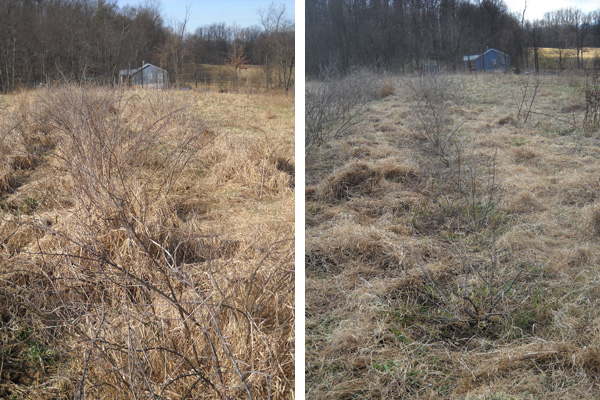Community /
Blogs
The opinions expressed in these blogs are solely those of the people who wrote them, and do not represent the views of WPSU or Penn State University.
Local Food Journey
The Zen of Weeding
Posted by James Eisenstein on 05/14 at 01:13 PM

Weeds among the asparagus (in dark rows). Photo Credit James Eisenstein.
You may think that spending some 20 hours hand weeding asparagus would be an onerous task, but only because you haven’t had to slog through grading a big stack of blue books or papers. I’d much prefer the weeding, though my knees and back provide a dissenting view.
It took about 20 seconds searching “asparagus weed pressure†on Google to confirm what I already knew: Asparagus is a poor competitor with weeds. Conventional growers douse their plantings with herbicides, including early applications of increasingly ineffective Glyphosate (Round-Up). Organic growers, however, aren’t allowed to use herbicides; we wouldn’t want to anyway. (See Why Organic Part 3.) So it’s down on your hands and knees to dig weeds from the asparagus rows, trusting you can mow or rototill, then mulch between the rows later.
Weeding can be a social activity or a solitary one. Working with others seems to make the work go faster. While working alone puts me in a state what I call “active meditation.†Meditation typically requires sitting still, often cross-legged, a challenge for an unpaid field hand like myself. My active meditation involves extended periods of repetitive physical activity, which is quite pleasurable. Moreover, the feeling of accomplishment when you complete the job is quite satisfying. Jealous? Want to enjoy this state? Just email me at .(JavaScript must be enabled to view this email address) and I’ll be delighted to invite you along for a future weeding adventure.
Asparagus is not the only crop offering such fun opportunities for active meditation. Just take a look at the before and after weeding and mulching of gooseberries below. I discovered many “daughter†gooseberry plants during the process, and, not having the heart to destroy them, I lovingly dug them up and transplanted them into a new row, 37 new rows to be exact.

Weed patch with gooseberries in its midst | Gooseberries after weeding and mulching. Photos Credit James Eisenstein.
Please start learning to love gooseberries (ridiculously easy to do once you have had them in a gooseberry pie or in preserves or baked with a chicken) because with luck we’ll harvest big crops in a few years.
Also, devoted readers of the Unpaid Field Hand series, may recall last year’s Mystery Crop featuring raspberries. Well, they’re baaack! I spent an exercise filled day wrestling with a lawn mower to cut the width of the beds to 15 inches and mow the weeds between the rows. Last year we left the rows three-feet wide, and the berries were small and not especially plentiful. With nothing to lose, we’re going to the recommended 15 inches. Stay tuned.
![]() Author: James Eisenstein
Author: James Eisenstein
Bio: Unpaid Field Hand at Jade Family Farm | Former Penn State Professor
Most recent entries
 Our Local Food Journey comes to an end
Our Local Food Journey comes to an end- Wednesday, January 31, 2018
- By Jamie Oberdick in Local Food Journey
 Winter isn’t a quiet time at the farm
Winter isn’t a quiet time at the farm- Wednesday, January 31, 2018
- By James Eisenstein in Local Food Journey
 Get the taste of garden season right now by growing herbs indoors
Get the taste of garden season right now by growing herbs indoors- Friday, January 26, 2018
- By Jamie Oberdick in Local Food Journey
 All you need to know about PASA’s Farming for the Future conference
All you need to know about PASA’s Farming for the Future conference- Friday, January 19, 2018
- By Jamie Oberdick in Local Food Journey
Categories
Archives
- January 2018
- December 2017
- November 2017
- October 2017
- September 2017
- August 2017
- July 2017
- June 2017
- May 2017
- April 2017
- March 2017
- February 2017
- January 2017
- December 2016
- November 2016
- October 2016
- September 2016
- August 2016
- July 2016
- June 2016
- May 2016
- April 2016
- March 2016
- February 2016
- January 2016
- December 2015
- November 2015
- October 2015
- September 2015
- August 2015
- July 2015
- June 2015
- May 2015
- April 2015
- March 2015
- February 2015
- January 2015
- December 2014
- November 2014
- October 2014
- September 2014
- August 2014
- July 2014
- June 2014
- May 2014
- April 2014
- March 2014
- February 2014
- January 2014
- December 2013
- November 2013
- October 2013
- September 2013
- August 2013
- July 2013
- June 2013
- May 2013
- April 2013
- March 2013
- February 2013
- January 2013
- December 2012
- November 2012
- October 2012
- September 2012
- August 2012
- July 2012
- June 2012
- May 2012
- April 2012
- March 2012
- February 2012
- January 2012
- December 2011
- November 2011
- October 2011
- September 2011
- August 2011
- July 2011
- June 2011
- May 2011
- April 2011
- March 2011
- February 2011
- January 2011
- December 2010
- November 2010
- October 2010
- September 2010
- August 2010
- July 2010
- June 2010
- May 2010
- April 2010
- March 2010
- February 2010
- January 2010
- December 2009
- November 2009
- October 2009
- September 2009
- August 2009
- July 2009
- June 2009
- May 2009
- April 2009
- March 2009
- February 2009

NO COMMENTS